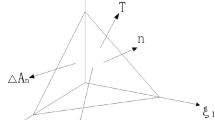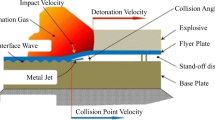Abstract
Some of the main progress on the investigation of the mechanism of the wave formation in explosive welding at the Institute of Mechanics is summarized and others' previous works are reviewed. Our systematic experiments and analysis do not substantiate the theory of wave formation based on Karman vortex-street analogy or Helmholtz instability. On the contrary, they show that material strength insensitive to strain rate plays an important role. A simple hydro-plastic model is presented to explain the main features regarding the interfacial wave formation and to estimate the magnitude of wave length. The result is in broad agreement with experiment.
Similar content being viewed by others
References
Crossland, B., Explosive Welding of Metals and Its Application, Clarendon Press, Oxford (1982).
Birkhoff, G., MacDougall, D. P., Pugh, E. M. and Taylor, G. I., Explosives with Lined Cavities,J. Appl. Phys., 19 (1948), 563–582.
Deribas, A. A., Explosive Welding, Siberian Branch of Academy of Sciences, U. S. S. R. (1967).
Milne-Thomson, L. M., Theoretical Hydrodynamics, 2nd Ed., MacMilan, London (1949).
Bahrani, A. S., Black T. J. and Crossland, B., The Mechanics of Wave Formation in Explosive Welding,Proc. Roy. Soc. (A), 296 (1976), 123–136.
Cowan, G. R. and Holtzmann, A. H., Flow Configuration in Colliding Plates: Explosive Bonding,J. Appl. Phys.,34 (1963), 928–939.
Cowan, G. R., Bergman, O. R. and Holtzman, A. H., Mechanism of Bond Zone Wave Formation in Explosive-Clad Metals,Met. Trans., 2 (1971), 3144–3155.
Kowalick, J. F. and Hay, D. R., A Mechanism of Explosive BondingMet. Trans.,2 (1971), 1953–1958.
Reid, S. R. and Sherif, N. H. S., Prediction of the Wave Length of Irterface Waves in Symmetric Explosive Welding,J. Mech. Eng. Sci.,18 (1976), 87–94.
Уткин, А. В., Дремин, А. Н., МихайΛов, А. Н. ГордоПолов, Ю. А., Волнообразование при Высокоскоростом соударений Металлов,Фуз. Гореня И взрывы, 16 (1980), Вып. 4.
Drazin, P. G. and Howard, L. H., Hyudrodynamic Stability of Parallel Flow of Inviscid Fluid, Adv. Appl. Mech. (1966).
Zhang Dengxia, Li Guohao, Zhou Zhibong, Shao Binghuang. The Role of Material Strength Playing in Wave Formation in Explosive Welding.Acta Mechanica Sinica, 16 (1984), 1, 73. (in Chinese).
Shao Binghuang, Li Guohao and Zhou Zhihong, Experimental Research on Prooess of Instability at the Interface in Explosive Weld, Proc. of the Int. Symp. on Intense Dynamic Loading and Its Effects, Science Press, Beijing, China (1986), 974.
Zhang Dengxia, Li Guohao, Zhou Zhihong and Shao Binghuang. Metallographic Analysis of Interface Zone in Impact Welding Specimen,Explosion and Shock Waves,3 (1983), 3, 37. (in Chinese).
Author information
Authors and Affiliations
Rights and permissions
About this article
Cite this article
Chemin, C., Qingming, T. Mechanism of wave formation at the interface in explosive welding. Acta Mech Sinica 5, 97–108 (1989). https://doi.org/10.1007/BF02489134
Received:
Revised:
Issue Date:
DOI: https://doi.org/10.1007/BF02489134




